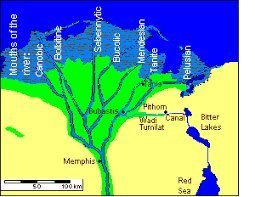
The Suez Canal blocked, what can they do?
The Suez Canal became famous recently when the container ship Evergreen got stuck in the canal. The Suez Canal is today’s major route for goods coming from the Far East to Europe. When it got blocked, the world panicked.
Today’s canal, which took ten years to build, was finished in 1869, it is 120 miles long and goes through three natural lakes.
However, the Egyptians had already built one back in ancient times, which was used, with a few interruptions until 767AD.
Everyone has heard of the Suez Canal, but did you know that 2,000 years ago the Egyptians had a canal they called the Canal of the Pharaohs.
The Egyptians built it in ancient times and it was used, with a few interruptions until 767AD.
Yes, there was a canal there 2,000 years ago!
It followed a different route
As the graphic above shows, it was a different route to the current Suez Canal, well for the last bit.
Basically it was a route that using exsisting waterways linked the River Nile to the Red Sea.
When was it built?
The Pharaohs begun it, but it was not finished until the Ptolemaic period under Ptolemy II.
They think originally it was started by Necho II in the late 6th century BC, but no one can agree when it was finally completed. There are interesting inscriptions comprising of five Egyptian monuments that commemorate the construction and completion of a canal linking the Nile River with the Red Sea by Darius I of Persia. These inscriptions were located along the Darius Canal through the valley of Wadi Tumilat and they probably recorded sections of the canal.
Then they came up with locks.
 This happenened after the death of Alexander the Great, when general Ptolemy declared himself Pharaoh of Egypt and his son, Ptolemy II, took up building the canal again.
This happenened after the death of Alexander the Great, when general Ptolemy declared himself Pharaoh of Egypt and his son, Ptolemy II, took up building the canal again.
However, the different water levels blocked him until, around 274 to 273 BC, when his engineers came up with the idea of the lock. This allowed them to regulate the flow of water between the Red Sea and Nile. Unfortunately, it was prone to the whims of the Nile, and therefore frequently silted up, due to the regular flooding. In fact under Roman Emperors Trajan and Hadrian they had to re-dig the canal.
When did it fall into disuse?
Islamic texts that discuss the canal, say that it silted up, then was reopened in 641 or 642 AD by Amr, the Muslim conqueror of Egypt. Then in around 760 A.D., the Abbasid Caliph, Abu Jafar El-Mansur, ordered the Canal be filled with sand as he wanted to stop the movement of goods to Mecca and Medina as where they were revolting against his rule.
That was that until Ferdinand de Lesseps in 1854 set up a new Suez Canal Company.
Now, isn’t History interesting?
10 questions to discuss:
- Beyond the recent EverGreen incident, what other historical events have highlighted the strategic importance of the Suez Canal?
- How might the existence of an ancient Egyptian canal have influenced the development of trade routes and regional economies in the past?
- What technological advancements or challenges were faced in constructing the different iterations of the Suez Canal, including locks and dredging?
- Beyond economic implications, what social and political consequences might have resulted from the opening and closing of the various canals throughout history?
- How did the Red Sea’s natural environment and water levels impact the construction and maintenance of the canals?
- The blog mentions different theories about the initial construction of the ancient canal. What archaeological evidence would help clarify its origins?
- How did the development of alternative trade routes, like the Cape of Good Hope, influence the use and importance of the Suez Canal over time?
- What environmental concerns or potential risks are associated with the current Suez Canal and its heavy shipping traffic?
- Are there any other historical or contemporary canals around the world that face similar challenges or play crucial roles in international trade?
- Considering the Suez Canal’s historical significance and recent events, what measures might be taken to ensure its smooth operation and resilience in the future?
These questions are to help with a deeper understanding of the historical context, technological advancements, and diverse impacts of the Canal across different time periods.
To get more nformation:
https://www.amusingplanet.com/2021/05/canal-of-pharaohs-forerunner-to-suez.html
https://www.wikiwand.com/en/Canal_of_the_Pharaohs
https://www.jstor.org/stable/545471
© Tony Dalton

